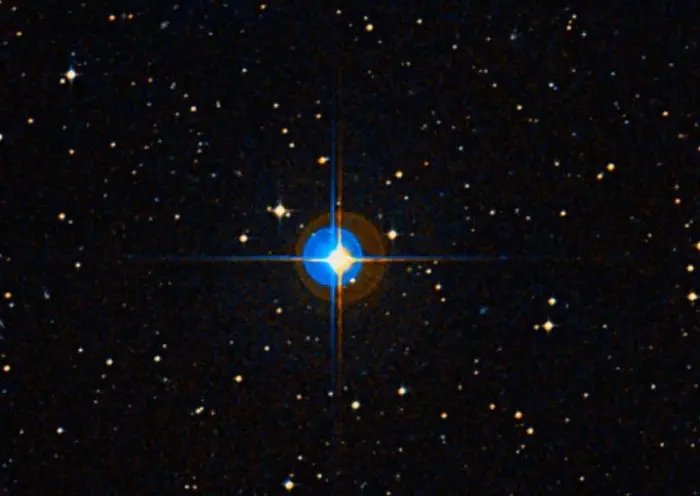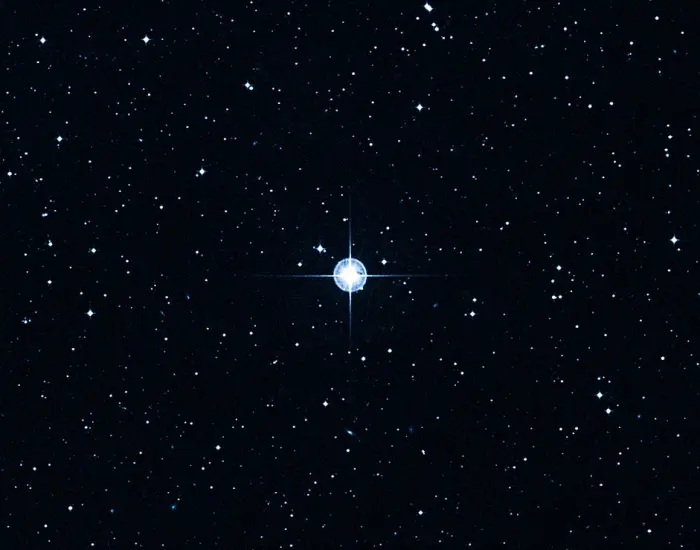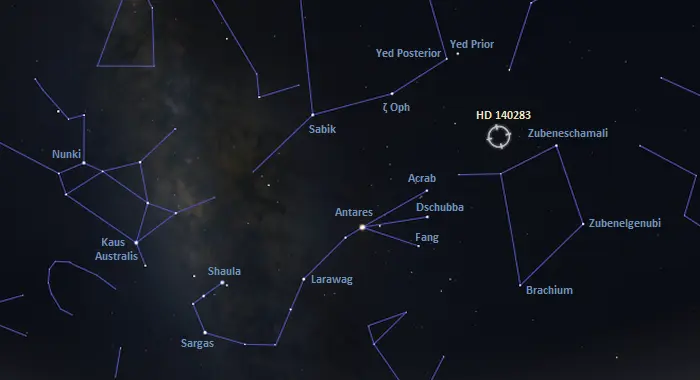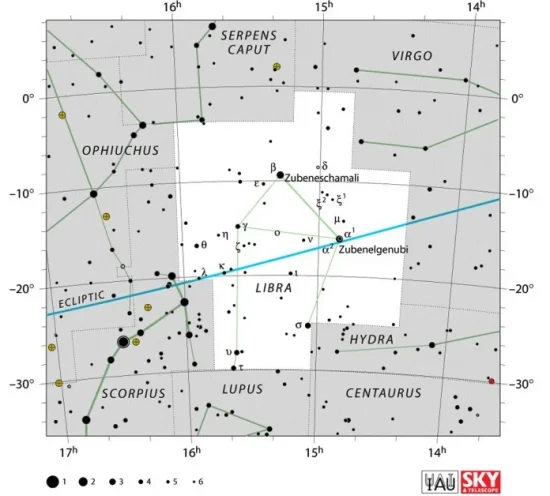Methuselah star (HD 140283) is a yellow subgiant located in the constellation Libra. With an estimated age of 12 billion years, it is one of the oldest stars known.
Located at a distance of 200.5 light years from Earth, Methuselah is one of the nearest Population II stars to the Sun. With an apparent magnitude of 7.205, the star is invisible to the unaided eye.
Star type
HD 140283 has the spectrum of a yellow subgiant star of the spectral type G0IV-V m-5. The metal-poor subgiant is neither a main sequence star nor has it evolved into a red giant.
The star has an estimated mass of 0.81 solar masses and a radius 2.04 times that of the Sun. With an effective temperature of 5,787 K, it is 4.82 times more luminous than the Sun. It spins at up to 3.9 km/s.
With a metallicity of -2.40 dex, Methuselah really earns its nickname. It is one of the most metal-poor (and therefore oldest) stars ever discovered.

Methuselah star (HD 140283), image: Wikisky (DSS2)
Age
Methuselah star has an estimated age of 12 billion years. The age estimate comes from a 2021 study by Jianling Tang of the Research School of Astronomy & Astrophysics, Australian National University, Canberra, and Meridith Joyce of the ARC Centre of Excellence for All Sky Astrophysics in 3 Dimensions (ASTRO 3D), Australia.
The astronomers used radial measurements obtained with the PAVO interferometer at the CHARA array (Center for High Angular Resolution Astronomy) in California to revise the stellar parameters for Methuselah. They derived a mass of 0.81 ± 0.05 solar masses and an age of 12 ± 0.05 billion years.
Previous age estimates for Methuselah made the old star appear older than the universe itself. The estimated age of 14.46 billion years was determined in a study published in 2013. At the time, Methuselah was the oldest star known. The study was conducted by a team of astronomers at the Space Telescope Science Institute (STScI) in Baltimore, MD, Department of Astronomy & Astrophysics, Pennsylvania State University, Dept. of Physics & Astronomy, University of Victoria, BC, the CHARA Array of Georgia State University, Mount Wilson Observatory, and the National Optical Astronomy Observatories (NOAO) in Tuscon, AZ.
The study used the Fine Guidance Sensors of the Hubble Space Telescope and measured a trigonometric parallax of 17.15 milliarcseconds for the star. The authors used the precise distance to determine the age of the star.
Earlier estimates were even higher. In 2000, observations with European Space Agency’s (ESA) Hipparcos satellite yielded an age of 16 billion years.
A 2014 study that used interferometric and spectroscopic measurements, as well as photometry, determined a limb-darkened diameter of 0.353 ± 0.013 milliarcseconds for Methuselah. The study derived a temperature of 5,534 K or 5,647 K and a radius of 2.21 solar radii.
The same study performed bolometric flux fitting for an interstellar extinction of 0.0 and 0.1 magnitudes and derived a mass of 0.780 solar masses and an age of 13.7 ± 0.7 billion years or a mass of 0.805 solar masses and an age of 12.2 ± 0.6 billion years, depending on the degree of extinction. The study suggested that asteroseismic observations were necessary to derive the star’s mass and age with a greater degree of certainty.
Another 2014 study updated the star’s age to 14.27 ± 0.38 billion years.
Is Methuselah the oldest star?
HD 140283 is one of the oldest stars known, but there are uncertainties in its estimated age. The age of the oldest stars is difficult to determine, but many exceptionally old stars currently have higher age estimates than Methuselah.
These other methuselahs include HE 1523-0901 (13.2 billion years) in the constellation Libra, Gliese 414 (12.4 ± 5.2 billion years) in Ursa Major, HD 122563 (12.6 billion years) in Boötes, BD+17°3248 (13.8 ± 4 billion years) in Hercules, J1808−5104 (13.535 ± 0.002 billion years) in Ara, SMSS J0313−6708 (13.6 billion years) in Hydrus, HE0107-5240 (about 13 billion years) in Phoenix, Sneden’s Star (BPS CS22892-0052, 13 billion years) in Aquarius, Caffau’s Star (SDSS J102915+172927, 13 billion years) in Leo, and Cayrel’s Star (BPS CS31082-0001, 12.5 ± 4 billion years) in Cetus.
With an estimated age of 13.6 billion years, it is SMSS J031300.36−670839.3 that is usually cited as the oldest star with an accurately determined age.
Is Methuselah older than the universe?
With an estimated age of 12 billion years, Methuselah is 1.787 billion years younger than the universe.
Even though the previously estimated age of Methuselah (14.46 ± 0.8 billion years) is higher than the age of the universe (13.787 ± 0.020 billion years), the star could not really be older because it could not have formed before the Big Bang. The estimate had a margin of error of 0.8 billion years, which meant that the star could have been as young as 13.66 billion years, which would not have conflicted with the age of the universe.
The age of the universe is one of the most researched topics in astronomy. The currently accepted age of 13.787 ± 0.020 billion years – the time elapsed since the Big Bang – takes into account the expansion rate of the universe, the cosmic microwave background radiation, and direct observation of the universe when it was at a much younger age. While there is always residual uncertainty, many studies give similar estimates for the age.
Even though HD 140283 is exceptionally old and made almost entirely of hydrogen and helium, it is not a Population III star since it does have some metals.
Population III stars are a hypothetical group of very massive and virtually metal-free stars that formed in the early universe, only a few hundred million years after the Big Bang. Like all exceptionally massive stars, they lived very short lives before going out as supernovae. These stars have not been observed directly, but some of them may still be visible in gravitational lensing, even though they are long gone.
Methuselah is a Population II star, a metal-poor star that formed when the universe was still young. Population II stars are usually cooler and less luminous than the younger Population I stars. Even though they have low metallicity (an indicator of an older age), Population II stars typically have a higher ratio of alpha process elements (oxygen, silicon, neon, and others) relative to iron. This may be due to Type II supernovae supplying more material to the interstellar medium when these stars were formed. The heavier elements supplied by Type Ia supernovae came later.
Facts
HD 140283 is a high-velocity star whose light is blueshifted because the star is moving in our direction. Methuselah has been known to astronomers for over a century due to its high proper motion and velocity. It travels across the sky so fast that it moves by a full Moon width in only 1,500 years.
The star’s fast motion across the sky indicates that Methuselah is only visiting our stellar neighbourhood at a speed of 1.3 million kilometres per hour (800,000 mph). Like many other exceptionally old Population II stars, it hails from the galactic halo. Its orbit through the Milky Way plane will eventually take it back to the Milky Way halo.
HD 140283 is believed to have formed in a dwarf galaxy that was swallowed by the Milky Way galaxy more than 12 billion years ago.

You can’t be older than your parents. But there is a nearby star that at first glance looks like it is older than the universe! Hubble Space Telescope astronomers are coming to grips with this paradox by improving the precision of the observations used to estimate the age of this “Methuselah star.” Around the year 2000, estimates for the star’s age were about 16 billion years. But the universe is about 13.8 billion years old, based on a meticulous calibration of the expansion of space and analysis of the microwave afterglow from the big bang. Hubble data and improved theoretical calculations were used to recalculate the star’s age and lower the estimate to 14.5 billion years, within a measurement uncertainty of plus or minus 800 million years. This places the star within a comfortable range to be younger than the universe. Astronomers have to collect a lot of information to deduce a star’s age because it doesn’t come with a birth certificate. They have to take into account where the star is in its life history, the detailed chemistry of the star, and its intrinsic brightness. Hubble’s contribution was to reduce the uncertainty on the star’s true distance. With that improved accuracy, the intrinsic brightness of the star is better known. The ancient star is still spry for its age. It is speeding past us at 800,000 miles per hour. Its orbit can be traced back to the halo of our galaxy, which is a “retirement home” for stars that were born long before the Milky Way was even fully assembled. Illustration Credit: Digitized Sky Survey (DSS), STScI/AURA, Palomar/Caltech, and UKSTU/AAOScience Credit: NASA, ESA, and H. Bond (STScI and Pennsylvania State University), E. Nelan (STScI), D. VandenBerg (University of Victoria), G. Schaefer (CHARA, Mt. Wilson Observatory), and D. Harmer (NOAO) (CC BY 2.0)
Name
HD 140283 does not have a proper name formally approved by the International Astronomical Union (IAU). The star was nicknamed Methuselah after the biblical figure, who is said to have lived for 969 years. Methuselah was the longest-lived figure in the Bible and HD 140283 was believed to be the oldest star known.
Methuselah star is commonly referred to by its designation in the Henry Draper Catalogue (HD), HD 140283. It is catalogued as Gliese 1195 (GJ 1195) in the Gliese Catalogue of Nearby Stars, HIP 76976 in the Hipparcos Catalogue, and SAO 159459 in the Smithsonian Astrophysical Observatory Star Catalog.
Location
Methuselah lies in the region of the sky between Zeta Ophiuchi in the constellation Ophiuchus and Zubeneschamali, the brightest star in Libra. A line drawn from Larawag, one of the bright stars of the Fish Hook of Scorpius, through Acrab in the Scorpion’s claws, points in the direction of Methuselah.
With an apparent magnitude of 7.205, the star requires binoculars to be seen.

The location of Methuselah star (HD 140283), image: Stellarium
Constellation
HD 140283 is located in the constellation Libra. Like other zodiac constellations, Libra was first catalogued by the astronomer Ptolemy of Alexandria in his Almagest, written around 150 CE. The constellation occupies 538 square degrees of the southern sky and is the 29th largest of the 88 constellations.

Libra constellation map by IAU and Sky&Telescope magazine
Once considered part of the neighbouring Scorpius, Libra’s brightest stars are easily recognizable because they appear as the extended claws of the celestial Scorpion. With only two stars brighter than magnitude 3.00, Libra is not particularly bright, but its scales asterism is visible in clear, dark skies near the claws of Scorpius.
Notable stars in Libra include the luminaries Zubeneschamali and Zubenelgenubi, the semiregular variable red giant Brachium, the yellow giant Zubenelhakrabi, and the red dwarf Gliese 581, which hosts three confirmed planets. The planets include Gliese 581c, an Earth-like planet found to be orbiting in the star’s habitable zone.
Libra is also home to the red giant HE 1523-0901, one of the oldest stars known.
Interesting deep sky objects in the constellation include the barred spiral galaxies NGC 5885 and NGC 5792, the active spiral galaxies NGC 5793 and NGC 5728, the unbarred lenticular galaxy NGC 5890, and the bright, large globular cluster NGC 5897.
The best time of the year to observe the stars and deep sky objects in Libra is during the month of June, when the constellation climbs higher above the horizon in the evening sky. The entire constellation is visible from locations between the latitudes 65° N and -90° S.
The 10 brightest stars in Libra are Zubeneschamali (Beta Lib, mag. 2.61), Zubenelgenubi (Alpha Lib, mag. 2.741), Brachium (Sigma Lib, mag. 3.29), Upsilon Librae (mag. 3.628), Tau Librae (mag. 3.68), Zubenelhakrabi (Gamma Lib, mag. 3.91), Theta Librae (mag. 4.136), 16 Librae (mag. 4.49), Iota1 Librae (mag. 4.54), and 37 Librae (mag. 4.61).
Methuselah star – HD 140283
| Spectral class | G0IV-V m-5 |
| Apparent magnitude | 7.205 ± 0.02 |
| Absolute magnitude | +3.377 |
| Distance | 200.5 ± 0.3 light-years (61.47 ± 0.10 parsecs) |
| Parallax | 16.2672 ± 0.0260 mas |
| Radial velocity | −169.00 ± 0.2 km/s |
| Proper motion | RA: −1115.141 ± 0.029 mas/yr |
| Dec.: −303.573 ± 0.021 mas/yr | |
| Mass | 0.81 ± 0.05 M☉ |
| Luminosity | 4.82 ± 0.27 L☉ |
| Radius | 2.04 ± 0.04 R☉ |
| Temperature | 5,787 ± 48 K |
| Metallicity | −2.40 ± 0.10 dex |
| Age | 12 ± 0.05 billion years |
| Rotational velocity | ≤ 3.9 km/h |
| Surface gravity | 3.6 cgs |
| Constellation | Libra |
| Right ascension | 15h 43m 03.0971190219s |
| Declination | −10° 56′ 00.595693188″ |
| Names and designations | Methuselah star, HD 140283, HIP 76976, SAO 159459, GJ 1195, BD−10 4149, CSV 101522, GC 21124, GCRV 9069, JP11 2636, LFT 1220, LHS 405, LPM 579, LTT 6279, NLTT 40989, LAL 28607, PLX 3552.00, PPM 230636, PM 15404-1046, UBV 13389, SRS 13112, GSC 05601-00694, Ci 20 942, NBP 217, NSV 7210, DENIS J154303.0-105600, GES J15430220-1056042, TD1 18486, UBV 13389, UBV M 20927, VVO 315, WEB 13056, WISEA J154302.33-105603.8, TIC 290565106, YZC 11 5477, YZ 0 5090, GALAH 140808000901102, 2MASS J15430307-1056009, TYC 5601-694-1, Gaia DR2 6268770373590148224, Gaia DR3 6268770373590148224 |